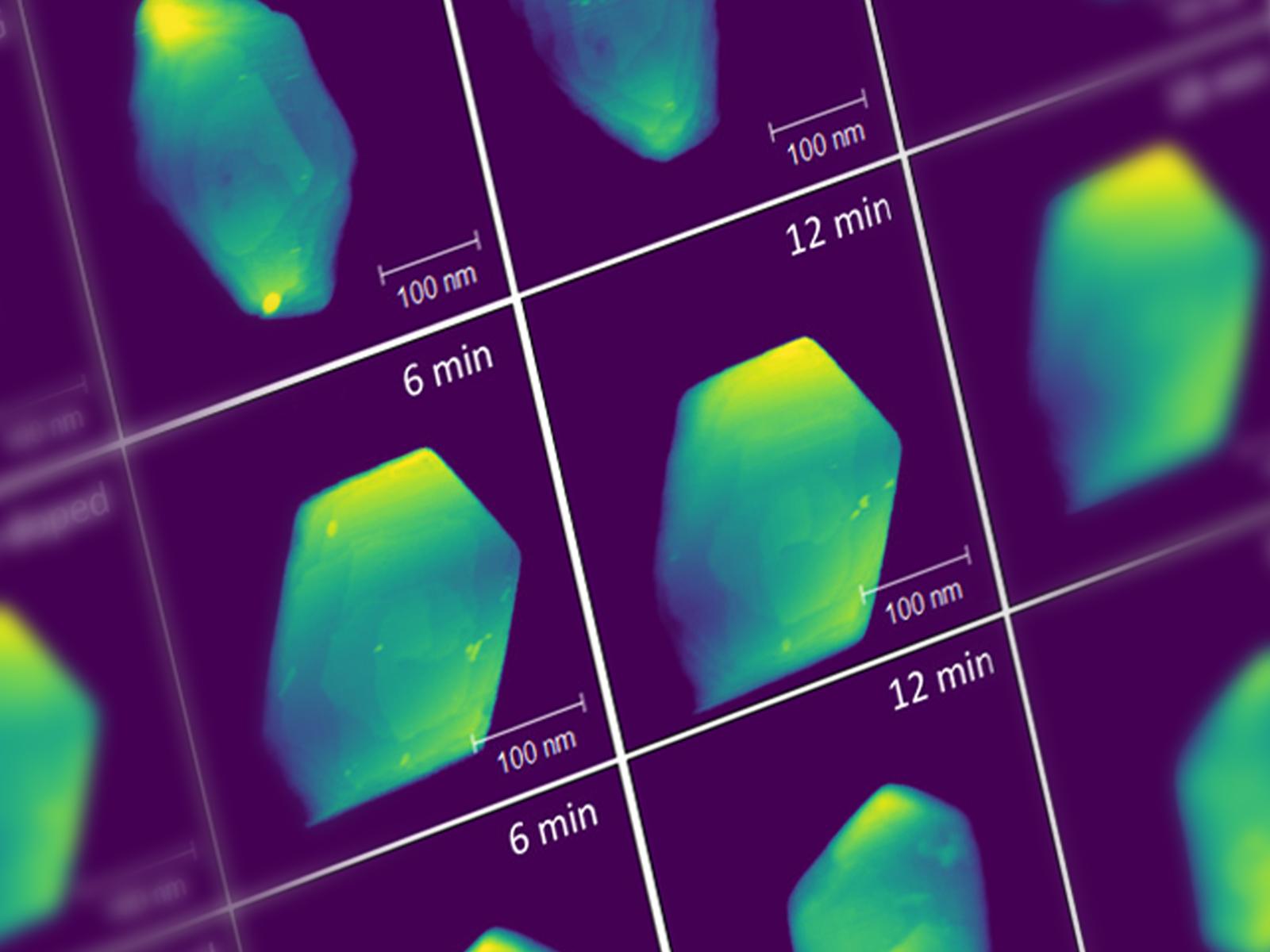Ion Incorporation Affects Mineral Behavior
Trace amounts of iron and chromium can incorporate into gibbsite, affecting how the mineral dissolves

The presence of small amounts of iron or chromium can significantly slow the dissolution of gibbsite.
(Composite image by Jeff London | Pacific Northwest National Laboratory)
The Science
Metals, including critical materials or harmful pollutants, can incorporate into minerals in small quantities. These metals act as dopants and can dramatically affect the minerals’ properties. The minerals can then store or transport the dopants, also influencing the overall mineral behavior. Researchers studied how iron and chromium incorporate into gibbsite, an aluminum-based mineral found in legacy radioactive tank waste from plutonium production. They found that both iron and chromium can replace aluminum in small quantities that do not disrupt the overall mineral crystal structure. Despite their limited presence, at around 0.4% incorporation, the dopants significantly slow the dissolution of gibbsite.
The Impact
Gibbsite is an important component of both legacy radioactive tank waste and soil minerals. Understanding how dopants affect its behavior is key to effective remediation of waste and accurate modeling of element cycling in the soil. By identifying how dopants change how gibbsite dissolves, these results can help researchers develop safer and more effective methods for processing and stabilizing nuclear waste. These insights are also relevant to other efforts for environmental remediation to both understand how to potentially trap metal contaminants in minerals and more effectively track how these elements move throughout the natural environment.
Summary
The incorporation of different elements as impurities in mineral phases can affect both how the elements move through the environment and how the minerals behave. Researchers studied the incorporation of trace amounts of iron and chromium into gibbsite, an aluminum-based mineral important in legacy radioactive tank waste and the soil. The team found that iron and chromium could be incorporated directly into the growing gibbsite crystals, rather than simply attaching to the surface. These dopants added to the gibbsite in trace amounts, approximately 0.4% dopant, and did not produce any evident structural changes in the mineral. However, the iron and chromium did notably influence the dissolution behavior of the gibbsite. Both dopants led to significantly slower gibbsite dissolution rates, with chromium causing a stronger effect than iron. Insights from this work can help improve processing of radioactive tank waste by revealing how the presence of dopants can selectively tune the stability of gibbsite solids.
Contact
Xin Zhang, Pacific Northwest National Laboratory, xin.zhang@pnnl.gov
Kevin M. Rosso, Pacific Northwest National Laboratory, kevin.rosso@pnnl.gov
Carolyn I. Pearce, Pacific Northwest National Laboratory, carolyn.pearce@pnnl.gov
Funding
This research was supported by Ion Dynamics in Radioactive Environments and Materials (IDREAM), an Energy Frontier Research Center funded by the U.S. Department of Energy, Office of Science, Basic Energy Sciences (FWP 68932). A portion of this research was performed with the user proposal 10.46936/lser.proj.2020.51382/60000186 at Environmental Molecular Sciences Laboratory, a DOE Office of Science user facility sponsored by the Biological and Environmental Research program under Contract No. DE-AC05-76RL01830. This research used resources of the Advanced Photon Source, a DOE Office of Science user facility operated for the DOE Office of Science by Argonne National Laboratory under Contract No. DE-AC02-06CH11357. Y.T.Z. acknowledges support from the China Scholarship Council. The authors thank PNNL scientist Charles T. Resch for help with the ICP-OES measurements.
Published: July 21, 2025
Zhao Y., M.P. Prange, M. Zong, Y. Wang, E.D. Walter, Y. Chen, and Z. Zhu, et al. 2024. "Understanding Trace Iron and Chromium Incorporation During Gibbsite Crystallization and Effects on Mineral Dissolution." Environmental Science & Technology, 58, no. 45:20125-20136. [doi:10.1021/acs.est.4c04483]